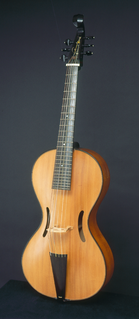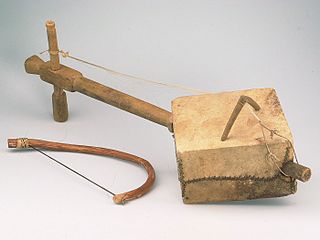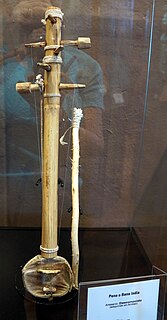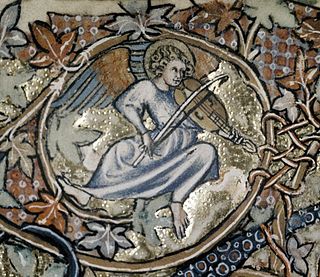 W
WThe Alexander violin is a string instrument designed by Sylvanus J. Talbott in the late 19th century in the United States. It is typically made with wood and various other materials.
 W
WThe arpeggione is a six-stringed musical instrument fretted and tuned like a guitar, but with a curved bridge so it can be bowed like a cello, and thus similar to the bass viola da gamba. The instrument is sometimes also called a guitar violoncello. The body shape of the arpeggione is, however, more similar to a medieval fiddle than either the guitar or the bass viol. It is essentially a bass viol with a guitar-type tuning, E–A–d–g–b–e'. The arpeggione is especially suited to playing runs in thirds, double stops, and arpeggios.
 W
WBowed guitar is a method of playing a guitar, acoustic or electric, in which the guitarist uses a bow, rather than the more common plectrum, to vibrate the instruments' strings, similar to playing a viola da gamba. Unlike traditionally bowed instruments such as violins, the guitar generally has a relatively flat bridge radius and closely positioned strings, making it difficult to bow individual notes on the middle strings. The technique is often associated with Jimmy Page of Led Zeppelin and the Yardbirds, as well as Jónsi of Sigur Rós. Eddie Phillips of the British group, the Creation, was one of the first rock guitarists to use a bow in their 1966 song "Making Time".
 W
WThe Byzantine lyra or lira was a medieval bowed string musical instrument in the Byzantine Empire. In its popular form, the lyra was a pear-shaped instrument with three to five strings, held upright and played by stopping the strings from the side with fingernails. The first known depiction of the instrument is on a Byzantine ivory casket, preserved in the Bargello in Florence. Versions of the Byzantine lyra are still played throughout the former lands of the Byzantine Empire: Greece, Crete, Albania, Montenegro, Serbia, Bulgaria, North Macedonia, Croatia, Italy and Armenia.
 W
WThe esraj is an Indian stringed instrument found in two forms throughout the Indian subcontinent. It is a relatively recent instrument, being only about 300 years old. It is found in North India, primarily Punjab, where it is used in Sikh music and Hindustani classical compositions and in West Bengal. The esraj is a modern variant of the dilruba, differing slightly in structure.
 W
WHuqin is a family of bowed string instruments, more specifically, a spike fiddle popularly used in Chinese music. The instruments consist of a round, hexagonal, or octagonal sound box at the bottom with a neck attached that protrudes upwards. They also usually have two strings, and their soundboxes are typically covered with either snakeskin or thin wood. Huqin instruments usually have two tuning pegs, one peg for each string. The pegs are attached horizontally through holes drilled in the instrument's neck. Most huqin have the bow hair pass in between the strings. Exceptions to having two strings and pegs include variations of huqin with three, four, and sometimes even more than five. These include the zhuihu, a three stringed huqin, the sihu, a huqin of Mongolian origin, and the sanhu, a lesser-known three-stringed variation.
 W
WThe hurdy-gurdy is a string instrument that produces sound by a hand-crank-turned, rosined wheel rubbing against the strings. The wheel functions much like a violin bow, and single notes played on the instrument sound similar to those of a violin. Melodies are played on a keyboard that presses tangents—small wedges, typically made of wood—against one or more of the strings to change their pitch. Like most other acoustic stringed instruments, it has a sound board and hollow cavity to make the vibration of the strings audible.
 W
WThe lira da braccio was a European bowed string instrument of the Renaissance. It was used by Italian poet-musicians in court in the 15th and 16th centuries to accompany their improvised recitations of lyric and narrative poetry. It is most closely related to the medieval fiddle, or vielle, and like the vielle had a leaf-shaped pegbox with frontal pegs. Fiddles with drone strings are seen beginning in the 9th century, and the instrument continued to develop through the 16th century. In many depictions of the instrument, it is being played by mythological characters, frequently members of angel consorts, and most often by Orpheus and Apollo. The lira da braccio was occasionally used in ensembles, particularly in the intermedi, and may have acted as a proto-continuo instrument.
 W
WThe lirone is the bass member of the lira family of instruments that was popular in the late 16th and early 17th centuries. It is a bowed string instrument with between 9 and 16 gut strings and a fretted neck. When played, it is held between the legs in the manner of a cello or viol.
 W
WThe masenqo also spelled masinko or ጭራ-ዋጣ (ዋጣ) in Tigrinya is a single-stringed bowed lute commonly found in the musical traditions of Ethiopia. As with the kirar, this instrument is used by Ethiopian minstrels called azmaris . Although it functions in a purely accompaniment capacity in songs, the masenqo requires considerable virtuosity, as azmaris accompany themselves while singing.
 W
WThe morin khuur, also known as the horsehead fiddle, is a traditional Mongolian bowed stringed instrument. It is one of the most important musical instruments of the Mongol people, and is considered a symbol of the nation of Mongolia. The morin khuur is one of the Masterpieces of the Oral and Intangible Heritage of Humanity identified by UNESCO.
 W
WPhilomel is the name of a musical instrument similar to the violin, but having four steel, wire strings.
 W
WThe rabeca or rabeca chuleira is a fiddle originating in Portugal, commonly used in both Portugal and Northeastern Brazil, where it is most commonly used in Brazilian forró music. It is descended from the medieval rebec.
 W
WThe rabel is a bowed stringed instrument from Spain, a rustic folk-fiddle descended from the medieval rebec, with both perhaps descended from the Arab rabab. The instrument generally has two or three strings of gut or steel, or sometimes twisted horse-hair. The instrument is first mentioned in the 12th century, and it is still used in parts of Latin America, as well as the Spanish provinces of Cantabria and Asturias.
 W
WA ravanahatha is an ancient bowed, stringed instrument, used in India, Sri Lanka and surrounding areas. It has been suggested as an ancestor of the violin.
 W
WThe rebab is the name of several related bowed string instruments that independently spread via Islamic trading routes over much of North Africa, Southeast Asia, the Middle East, and parts of Europe.
 W
WThe rebec is a bowed stringed instrument of the Medieval era and the early Renaissance. In its most common form, it has a narrow boat-shaped body and 1-5 strings. Played on the arm or under the chin, the technique and tuning may have influenced the development of the violin.
 W
WThe ukelin is a bowed psaltery with zither strings made popular in the 1920s. It is meant to be a combination of the violin and the Hawaiian ukulele. It lost popularity prior to the 1970s because the instrument was difficult to play and often returned to the manufacturer before it had been completely paid for.
 W
WThe vielle is a European bowed stringed instrument used in the medieval period, similar to a modern violin but with a somewhat longer and deeper body, three to five gut strings, and a leaf-shaped pegbox with frontal tuning pegs, sometimes with a figure-8 shaped body. Whatever external form they had, the box-soundchest consisted of back and belly joined by ribs, which experience has shown to be the construction for bowed instruments. The most common shape given to the earliest vielles in France was an oval, which with its modifications remained in favour until the Italian lira da braccio asserted itself as the better type, leading to the violin.
 W
WThe viola organista is a musical instrument designed by Leonardo da Vinci. It uses a friction belt to vibrate individual strings, with the strings selected by pressing keys on a keyboard. Leonardo's design has intrigued instrument makers for more than 400 years, but though similar instruments have been built, no extant instrument constructed directly from Leonardo's incomplete designs is known. Sometimes it is mistakenly referred to as the harpsichord viola, which is a different instrument.
 W
WThe yaylı tambur is a bowed long-neck lute from Turkey. Derived from the older plucked mızraplı tambur variant of the Turkish tambur, it has a long, fretted neck and a round metal or wooden soundbox which is often covered on the front with a skin or acrylic head similar to that of a banjo.
 W
WThe yazheng is a Chinese string instrument. It is a traditional zither similar to the guzheng but bowed by scraping with a sorghum stem dusted with resin, a horsehair bow, or a piece of forsythia wood. The musical instrument was popular in the Tang Dynasty, but is today little used except in the folk music of some parts of northern China, where it is called yaqin.